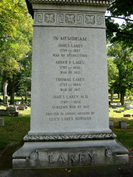
Thomas fought in the War of 1812. He was a constable (1820) and a school inspector (1819 to 1820) in the village of Palmyra. In 1828, he owned a blacksmith and wagon/carriage shop in the village.
From 1823 to 1869, Thomas was involved in sixty-eight land purchases and forty-five sales.[1] He was not the property entrepreneur these figures suggest. He was a middle man between the buyer and seller of property, much like a realtor today.
When it became apparent that sales of the Book of Mormon would not cover Martin Harris’s obligation to printer E. B. Grandin, Martin needed to make good on the contractual agreement for rumors circulated that he planned to default. To quiet the rumors and solve the problem, Martin entered a contractual arrangement with Thomas Lakey. In a decided effort to repay E. B. Grandin the contracted $3,000 debt, Martin agreed on April 1, 1831 to sell to Thomas Lakey 150 acres of his farm in Palmyra for twenty dollars per acre. The terms of the purchase agreement were as follows:
Articles of agreement made and concluded this first day of April in the year Eighteen hundred and thirty one between Martin Harris of the one part and Thomas Lakey of the other part both of Palmyra in the County of Wayne and the State of New York in manner and form following: The said Martin Harris for the consideration hereinafter mentioned agrees to sell to the said Thomas Lakey the farm on which he now resides containing by estimation one hundred and fifty acres [the indenture will read “one hundred and fifty one acres”] for the sum of twenty Dollars for each acre and, forthwith to obtain a correct survey of the said premises & to give a good warranty deed of same & give immediate possession of everything always excepting & reserving the privilege of living in the house till the first of May next—the said Lakey is to have all the wheat on the ground except ten acres sown by [Flanders] Dike & the one half of the said ten acres shall belong to the said Lakey after the said Dike shall harvest the same an[d] shock it up in the field—In consideration whereof the said Thomas Lakey agrees to pay to the said Martin Harris one third of the said purchase money on the first day of May next and one third in the month of October next and the remaining third in the month of October in the year Eighteen hundred and thirty two. In Consideration whereof the parties bind themselves in the penal sum of five hundred Dollars being Damages assessed and agreed on by the parties—In witness whereof, the parties have hereunto interchangeably set their hands and seals the day and year first above written. MARTIN HARRIS, L. S. THOMAS LAKEY, L. S.
Through the process of selling his property, Martin Harris gave Thomas Lakey a copy of the Book of Mormon. It is believed that copy was purchased for $50 from Caroline Lakey Hirsch and given to the Church.[2]
Thomas Lakey was essentially a middle man in the contractual agreement between Martin Harris and E. B. Grandin. As such, he was always on the lookout for a potential buyer. Thomas found a buyer for the Martin Harris property in Englishman John Graves. Graves had come to Walworth, New York (north of Palmyra) with his wife and daughter, Mrs. Christina Graves Grainger, a widow with four children. Christina Grainger had three thousand dollars in gold wrapped in a belt fastened about her waist as she voyaged to America. She willingly advanced the gold to her father to purchase 150 1/4 acres of the Martin Harris farm from Thomas Lakey, who tacked on an extra $300 as his mark up (realtor’s commission), or charged John Graves $3,300 on January 28, 1832. Lakey, in turn, gave $3,000 to Martin Harris, who presented E. B. Grandin with monies to satisfy the debt. Descendants of Christina Grainger claim that the gold used in the transaction went to Grandin and paid for the printing of the Book of Mormon. [3]
With all his putting together of real estate deals, Thomas never became wealthy. In 1860, he was a master wagon maker with a real wealth of $2,500 and a personal wealth of $500. He died at age sixty.
Through all of this, Thomas never wrote for or against Joseph Smith or Mormonism. In all that is written of him, nothing appears to show that he had any interest in the Prophet Joseph or Mormonism.
[1] Index to Grantees, Wayne County, NY.
[2] Willard Bean to Joseph F. Smith, November 30, 1934.
[3] Patton, “How it was my Great-Grandmother’s Gold paid for the printing of the first edition of the Book of Mormon,” Mss. 9852, Church History Library; Thomas Lakey to John Graves, January 28, 1832, Wayne County, NY, Property Deeds, Book 10:515–516, 11:128–129.
